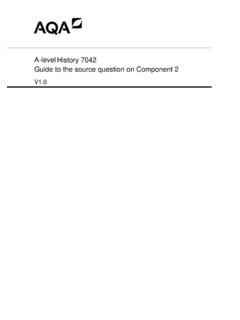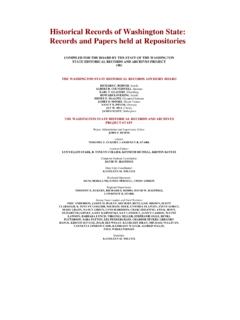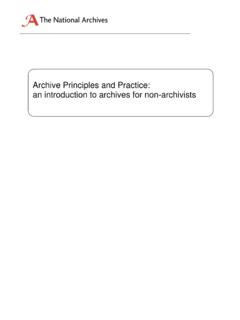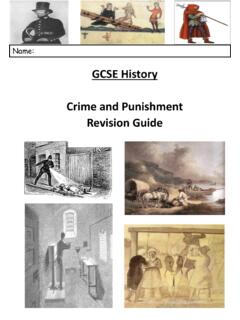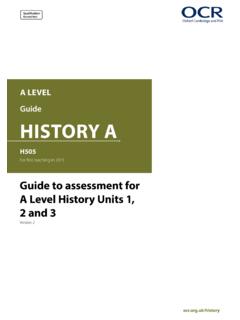Transcription of A Brief Guide - Stanford University
1 A Brief Guide TO WRITING IN art history Table of Contents The Purpose of Art Writing 1 Object Label 3 Catalogue Entry 5 Formal Analysis 8 Research Essay 12 Research 12 Thesis-Driven Essay 15 Problem-Driven Essay 16 Research Questions 16 Beginning 18 Paragraphs 18 Footnotes 19 Organization 19 Drawing Conclusions 20 Revision 20 First Person 21 Compare-Contrast Essay 22 Language 23 Bibliography 24 1 2 Chocolate Heads dancer at Cantor Arts Center. Toni Gauthier. Stanford Arts. March 6, 2013. The Purpose of Art Writing Works of art seem, by their very nature, to resist language. The ones we return to may leave us more with wordless feelings than coherent arguments.
2 If art and the emotions attendant to it reside outside language, how can the writer in art history proceed? Writing about art need not be a substitute for art, though. Indeed, the aim of art writing is not to be the work it describes, but rather to bring readers (back) to the work to see it better. Faced with your assignment, a helpful place to begin is with a question: What is this art asking me to see, that I do not already see? Look closely: sit with the work if it is at a museum, watch a film s scenes multiple times, make several visits to a work of architecture, or study the work in ArtStor so you can zoom in and examine its details with each encounter, take notes. Then visit the library. Library research allows you to set the object in its moment and put yourself in dialogue with art historians.
3 Finally, embarking on your draft, ask yourself: How can I help my reader see the newness of this work and the past itself? Writing in art history will help you develop the following skills: (1) a keen, receptive, curious gaze, (2) an openness to the emotive, cognitive and affective qualities of artworks, (3) confidence using library databases and accessing academic collections, (4) the ability to describe with accuracy a work of architecture, film, sculpture, performance, painting, photograph, art object, and (5) facility reading and analyzing others research. In practicing these skills, you develop your ability to gain and communicate insights into visual culture. The goal of the art historian is to reveal a 3 work of art to the reader.
4 Things otherwise unseen become visible, thanks to the art historian s words. 1 Even as writing in art history aims at new ways of seeing, it avoids absolutist claims, remaining keen to the way objects always exceed meaning. Writers in the field will often begin a project with a sustaining question instead of a totalizing thesis. For example: What makes this art? How is this work challenging conventions within its genre? How is this film both of and against its time? Why were these artists included and these others excluded? What values are expressed in this museum space? Art writing further gains in persuasiveness by avoiding projection or personal narrative. When Art Historians attend, over time, to a work s materials, components, influences, context, iconography and historical lineage, they are letting the art speak first.
5 You can see, too, that there are many paths into an artwork; out of this diversity and the biases that shape them, debates in the field grow. As with most writing in the humanities, then, writing in art history depends upon careful attention to and analysis of primary sources, alongside archival research (including written records of the past, physical remains and social and cultural rituals). Unlike most writing in the humanities, its central move is from the sensory or spatio-visual to the verbal. 1 Nemerov, The Art of Description, 5. 4 COMMON TYPES OF art history ASSIGNMENTS Here are four types of the most common writing assignments in art history courses. Like a telescope, each assignment extends from the previous one, reframing the relationship between reader, art and writer (the writer being the one who experiences the work analytically, physically, socially, affectively, etc.)
6 The more you approach the various genres of writing in art history as responsive to specific situations and expectations, the more effective your writing can become. I. OBJECT LABEL This writing appears alongside artworks on display at a museum and is meant to increase visitors understanding. It can provide visitors with a context or frame of reference for approaching a work or engage visitors by guiding their attention to points of interest within the work. Labels should be no more than 50 words, written in an accessible style and compel the visitor to look back to the work rather than walk on. i. Organization and Content An object label should provide, at a minimum, short factual information about the object and its creation.
7 This includes categories such as: What it is Where, when and by whom it was made (on second reference, always refer to the artist by last name) The materials and techniques used to make it Any inscriptions on it Writing the sentences that follow can be quite challenging as you confront an array of facts and values alongside the need to distil and select. To help with this process, define the objectives of the exhibit and its target audience. Then draw on the following stylistic suggestions to engage the visitor: Address the visitor in the first person Use active voice and relatively short sentences Provide familiar points of comparison Ask questions that compel the visitor to look again, look closely, reconsider Put the most important idea first.
8 5 ii. Example Here is an example of an object label in the Anderson Collection: Willem de Kooning was an action painter and central artist in the New York School. The artist s pink women are statuesque, made of broad brushstrokes and saturated colors. Picasso s Les Desmoiselles D Avignon seems present in the angular lines and geometric nose and legs of Woman Standing Pink, though de Kooning denied any influence of cubism on his work. Willem de Kooning described his drawing process as guided by a sense of intuition. He made his drawings of women, not unlike Woman Standing Pink, with his eyes closed. __ This object label for the de Kooning might surprise you. The image looks frightening, monstrous, powerful.
9 It can provoke strong feelings in students: misperceived as a woman, uncomfortable with the angular breasts and wayward eye, uncertain if this figure is violent or silenced or both. The object label doesn t address these possible responses, however. Instead it situates the painting in its art historical context, placing it in relation to other artists, artworks and movements. The label also speaks to the fairly unique conditions of its production, encouraging viewers to turn back to the painting in a way that differs from and perhaps even challenges an initial viewing. All without telling you how this writer feels before the work or how you, as a reader/museum visitor might be feeling. For more examples of Object Labels at the Anderson, you can visit the Anderson Collection website.
10 Willem de Kooning b. 1904, Rotterdam, Netherlands d. 1997, Long Island, NY Woman Standing-Pink, 1954-1955 oil and charcoal on canvas 48 x 36 in. Acquired from Martha Jackson Gift of Harry W. and Mary Margaret Anderson, and Mary Patricia Anderson Pence. Medium: oil Movement: New York School 6 II. CATALOGUE ENTRY This genre of writing appears in an exhibit catalogue alongside a reproduction of the object. It is written for a general audience and can be distinguished from the catalogue raison e, which is written for specialists (art historians, dealers and collectors). To engage the non-specialist reader, present your scholarship in a way that is both accessible and engaging. Include technical terms only when necessary and define them when you do.
